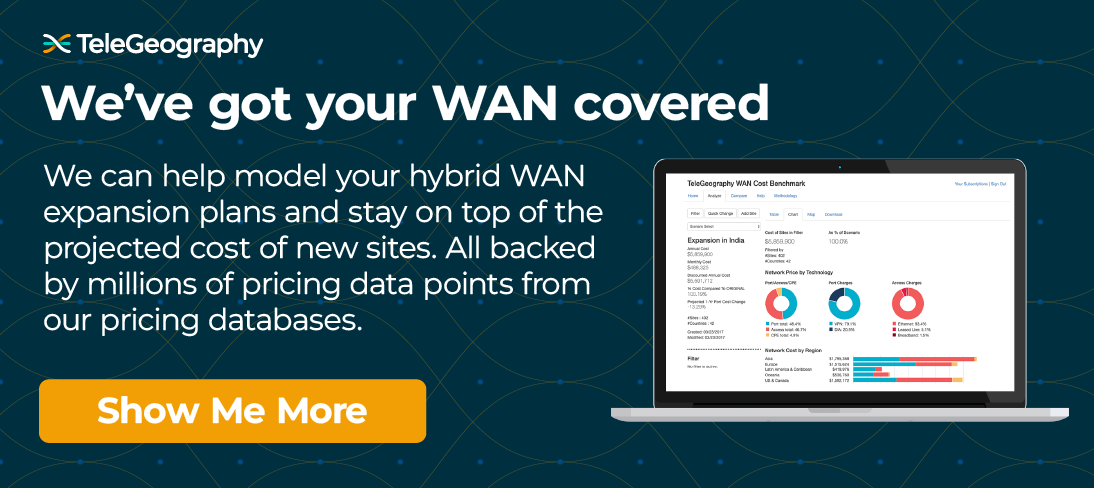Around three in four enterprises that responded to our latest WAN Manager Survey reported having multiple infrastructure as a service (IaaS) partner. Azure and AWS were easily the most frequently cited by participants; 60% were using one or both of these providers.
With this in mind, how are enterprises connecting to their IaaS providers and why would you select one method over another? And what's the global geographic distribution of cloud providers looking like these days?
This is why we had to have Principal Analyst Patrick Christian on the podcast. We're overdue to talk about cloud and WAN infrastructure. Lucky for us, this is Patrick's specialty. He had an hour to spare, and he brought us a new map to help us visualize the cloud.
Once we hit record, Greg asked about all things cloud, data center strategy, the latest insider lingo (Regions vs. availability zones?), and the controversial politics of using video during conference calls. (Listen all the way through to hear Greg's sartorial strategy for video calls.)
Enjoy the full episode below.
Start listening every week:
Apple | Google | Stitcher | TuneIn | Podbean | RSS
Key Takeaways
Enterprises are migrating away from exclusively on-premises data centers, driven by connectivity and ecosystem benefits.
Only one in ten enterprises surveyed still had all their data centers fully on-premises. The overwhelming majority (about 85%) had more than two data centers, with nearly half having between three and six.
A major reason cited for this move, beyond economics and scalability, is the connectivity offered by carrier-neutral colocation sites. These facilities provide access to a vast ecosystem of network and cloud service providers, making it much easier for enterprises to connect to multiple vendors compared to traditional corporate buildings where only a few providers may have wired connections.
The physical geography of cloud infrastructure critically impacts performance and cost, particularly in less developed markets.
While major markets in the US, Western Europe, and parts of East Asia have close access to cloud data centers, regions further afield like Latin America, the Middle East, and Africa still face significant latency issues because content and cloud data centers have historically been located elsewhere, often routing traffic back to Europe or the U.S.
This not only affects the performance of latency-sensitive applications but also increases connectivity costs, as traffic might need to transit over longer distances. Tracking the geography of where cloud providers build their data centers, on-ramps, and network infrastructure is therefore essential for WAN managers designing their networks.
Enterprises are connecting to the cloud using a mix of methods, with dedicated connections being the most common and evolving network provider roles.
According to WAN manager survey data from 2019, about 70% of respondents used some kind of direct connect (either from an NSP or CSP), and 60% used IPsec connections for some of their cloud connectivity.
Basic internet was used by about 40%, and peering by a similar percentage, while cloud exchanges were used by only 15%.
Network service providers are actively repositioning themselves as crucial "cloud connectors," facilitating enterprise connectivity to cloud service providers. Simultaneously, cloud service providers are increasingly offering their own network services (like virtual WAN or global reach), leveraging their extensive global network capacity to carry enterprise traffic, especially for long-haul connections.
Understanding the underlying wholesale network infrastructure is becoming more important for WAN managers to ensure redundancy, manage costs, and avoid issues like relying on a single provider or limited submarine cable capacity.
Patrick Christian
Patrick Christian is a Senior Research Manager with TeleGeography. He heads the Cloud and WAN Research Service. He also focuses on African and European markets specializing in international bandwidth markets and internet infrastructure, WAN services, terrestrial and submarine cable systems, and international voice traffic analysis.
Greg Bryan
Greg is Senior Manager, Enterprise Research at TeleGeography. He's spent the last decade and a half at TeleGeography developing many of our pricing products and reports about enterprise networks. He is a frequent speaker at conferences about corporate wide area networks and enterprise telecom services. He also hosts our podcast, TeleGeography Explains the Internet.






